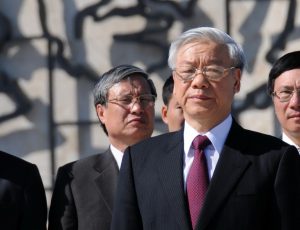Late last month, Vietnamese police arrested Nguyen Duc Chung, the Chairman of the Hanoi People’s Committee, for the alleged appropriation of documents containing state secrets. The charges relate to an investigation into the Hanoi tech giant Nhat Cuong Technical Services Trading Co. Ltd., whose general director has been accused of smuggling and the embezzlement of tens of millions in revenues.
Chung is just the latest senior official to be swept up in an ongoing Communist Party of Vietnam (CPV) campaign against graft, mismanagement and nepotism that has spread through the ranks of the party and into Vietnam’s powerful state-owned enterprises. Accelerating after the CPV’s 12th National Congress in 2016, anticorruption investigations have scooped up dozens of culprits, from local officials to high-ranking party apparatchiks to executives at leading state firms.
Among the most prominent recent cases is that of Tran Van Minh, the former party chairman of the coastal city of Danang, who was arrested in late 2018 along with a number of associates, on charges of mismanaging a state-owned enterprise.
Tran joined former Ho Chi Minh City party chief Dinh La Thang, who was arrested the previous year, seven months after being fired and removed from Vietnam’s 19-member Politburo, its core decision-making body. Dinh is accused of “very serious mistakes and violations” committed while he was chair of PetroVietnam, the country’s tentacular state-owned oil and gas company.
The resulting trials have resulted in a spate of death sentences and lengthy prison terms for guilty officials and executives, with intimations of further retribution to come.
Vietnam’s antigraft drive is the brainchild of the CPV’s 76-year-old General Secretary Nguyen Phu Trong, who took the party’s top post in early 2011, at a time of growing corruption at the highest ranks of the party-state. Much of this has been laid at the door of Nguyen Tan Dung, the economically more liberal southerner who served as prime minister from 2006 to 2016. During Dung’s decade in office, Vietnam saw impressive economic growth and foreign investment punctuated by major graft and nepotism scandals, some involving cashed-up offspring of important government and party officials.
One case involving Vinashin, a state-owned shipbuilder that ran up a $4.5 billion debt and defaulted on $600 million in loans, was so serious that it prompted Moody’s to downgrade Vietnam’s sovereign credit rating in late 2010.
On one level, then, the anticorruption drive represents an effort to extirpate the endemic corruption that threatens to undermine the stability and legitimacy of CPV rule. Back in 2012, Trong told reporters that “so many party members have gotten richer so quickly, leading a lavish life that is miles away from that of the workers.”
Yet at a deeper level, Vietnam’s anticorruption drive has been limited and shaped by the complex web of patron-client ties and political factionalism that lies behind the CPV’s revolutionary-red facade.
In this sense, the current crackdown can also be seen as an outgrowth of the wider power struggle between Nguyen Phu Trong and Nguyen Tan Dung, who was forced to stand down after unsuccessfully challenging Trong for the top party post at the 12th National Congress in 2016.
Trong’s victory was quickly followed by the resuscitation of an antigraft decree that was passed by the CPV Central Committee early in his tenure, but had lain dormant under Dung’s leadership. This was then used to sweep stray patrons and allies of Dung from the party’s ranks, and to tighten Hanoi’s hold on outlying regions of Vietnam.
While the struggle between Dung and Trong has been shadowed by ideological differences — to wit, an intraparty tension between more liberal, pro-Western party officials and a hidebound conservative old guard that views China as essential to the CPV’s long-term survival — it is in practice as much about patronage as principles.
Shortly after being granted a second term in office and seeing off his rival Dung, Trong cryptically announced, “I’m not going to break the vase just to catch some mice.” Trong seemed to be implying that nothing — not even the imperative of rooting out corruption — justified risks to the CPV’s hold on power. The logical inference is that there are limits to how far and how deep Vietnam’s anticorruption drive can afford to go, in a system whose mix of market incentives and state-ownership continues to provide ample opportunity for graft and embezzlement.
In 2002, the British academic Martin Gainsborough penned an article in which he argued, “What we often refer to as ‘reform’ is as much about attempts by rival political-business interests to gain control over financial and other resources.” Writing about the anticorruption campaign in 2017, David Brown, a former U.S. diplomat, made the same point, but more tersely: “Trong’s campaign looks more like a vendetta than a housecleaning.”































